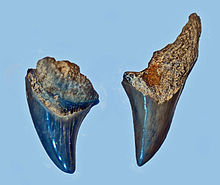Parotodus
| Parotodus | |
|---|---|

| |
| Fossil teeth of Parotodus benedenii | |
| Scientific classification | |
| Domain: | Eukaryota |
| Kingdom: | Animalia |
| Phylum: | Chordata |
| Class: | Chondrichthyes |
| Subclass: | Elasmobranchii |
| Order: | Lamniformes |
| Family: | incertae sedis |
| Genus: | †Parotodus Cappetta, 1980 |
| Type species | |
| †Parotodus benedenii Le Hon, 1871
| |
| Species | |
| |
Parotodus, commonly known as the false-toothed mako shark (or false mako shark), is an extinct genus of mackerel shark that lived approximately 53 to one million years ago during the Eocene and Pleistocene epochs. Its teeth, which are found worldwide, are often prized by fossil collectors due to their rarity. The scarcity of fossils is because Parotodus likely primarily inhabited open oceans far away from the continents. While the placement of Parotodus with the Lamniformes has been debated, most researchers agree it was probably a member of a now extinct shark clade, either a otodontid or a cardabiodont. In any case, it would have been the last members of either group. While originally being suspected of dying out at the very end of the Pliocene, fossils found in the Waccamaw Formation show that it made it to the Pleistocene.
Description
[edit]Initially appearing as a small shark, Parotodus gradually increased in size over geologic time and by the Neogene period became one of the largest sharks of its time.[4] A 1999 study estimated the genus to have measured up to 7.6 meters (25 ft) in length.[5] The teeth of Parotodus are distinctively curved and rarely show feeding damage, which suggests that it mainly preyed on soft-bodied animals. Paleontologists speculate that this included other sharks, including the contemporaneous Megalodon.[6]
Classification
[edit]Due to the general scarcity and ambiguity of fossils, the familiar placement remains uncertain. Several proposals suggest classifying the genus as a mega-toothed shark, cardabiodont, archaeolamnid, thresher shark, or white shark.[4][7]
Currently, three valid species are generally recognized within Parotodus. These include P. benedenii, P. pavlovi, and P. mangyshlakensis. However, some scientists, especially those who identify Parotodus as a cardabiodont, do not recognize the latter two as members of the genus.[4]
A fourth species was reported by Ward, Nakatani, and Bernard in a 2017 poster from the Oligocene of Japan. The poster stated that the new species is to be named after Yasuhiro Fudouji, the paleontologist who discovered the type specimens, and will be formally described in an upcoming paper. However, the scientific name was not explicitly stated to avoid an accidental invalidation of the taxon.[6]
Fossil records
[edit]
The genus is often regarded as a rare species despite its presence in ocean deposits worldwide. As a result, it is often prized by fossil collectors. Paleontologists believe that Parotodus likely inhabited primarily open oceans like the modern oceanic whitetip shark and blue shark. This would explain why fossils of a cosmopolitan animal are so rare, given that open oceans are seldom represented in terrestrial fossil deposits. This hypothesis is additionally supported by how Parotodus teeth are unusually common in nodule deposits under the Pacific and Indian Oceans and on islands located far away from continental lands.[4]
Parotodus fossils have been recovered from fossil deposits in the Azores, Mallorca, Malta, Europe, Madagascar, Kazakhstan, Japan, South Korea, South Africa, New Zealand, Australia, Peru, California, the East Coast of the United States, and dredged from the Pacific and Indian Oceans.[4][8]
References
[edit]- ^ Iserbyt, A.; De Schutter, P.J. (2012). "Quantitative analysis of Elasmobranch assemblages from two successive Ypresian (early Eocene) facies at Marke, western Belgium". Geologica Belgica. 15 (3): 147–156.
- ^ Steurbaut, E. (2006). "Ypresian". In Dejonghe, L. (ed.). Current status of chronostratigraphic units named from Belgium and adjacent areas. Vol. 9. pp. 73–93.
{{cite book}}:|journal=ignored (help) - ^ Boessenecker, S.J.; Boessenecker, R.W.; Geisler, J.H. (2018). "Youngest record of the extinct walrus Ontocetus emmonsi from the Early Pleistocene of South Carolina and a review of North Atlantic walrus biochronology" (PDF). Acta Palaeontologica Polonica. 63 (2): 279–286. doi:10.4202/app.00454.2018.
- ^ a b c d e Canevet, J. (2019), "Le genre Parotodus: le faux requin-mako", Fossiles (in French), no. 37, pp. 39–50
- ^ Kent, B.W. (1999). "Speculations on the Size and Morphology of the Extinct Lamnoid Shark, Parotodus benedeni (le Hon)" (PDF). The Mosasaur. 6: 11–15.
- ^ a b Ward, D.J.; Nakatani, D.; Bernard, E.L. (2017), A new species of Parotodus (Lamniformes: Otodontidae) from the Oligocene of Japan, The Palaeontological Association, doi:10.13140/RG.2.2.33171.58404
- ^ Kent, B.W. (2018). "The Cartilaginous Fishes (Chimaeras, Sharks, and Rays) of Calvert Cliffs, Maryland, USA". In Godfrey, S. J. (ed.). The Geology and Vertebrate Paleontology of Calvert Cliffs, Maryland, USA. pp. 45–157. ISSN 1943-6688.
{{cite book}}:|journal=ignored (help) - ^ Tatiana P. Malyshkina; David J. Ward; Mikhail V. Nazarkin; Gi-Soo Nam; Seung-Hyuk Kwon; Jeong-Hyun Lee; Tae-Wan Kim; Do-Kwon Kim; Doo-Sung Baek (2022). "Miocene Elasmobranchii from the Duho Formation, South Korea". Historical Biology. 35 (9): 1726–1741. doi:10.1080/08912963.2022.2110870.
